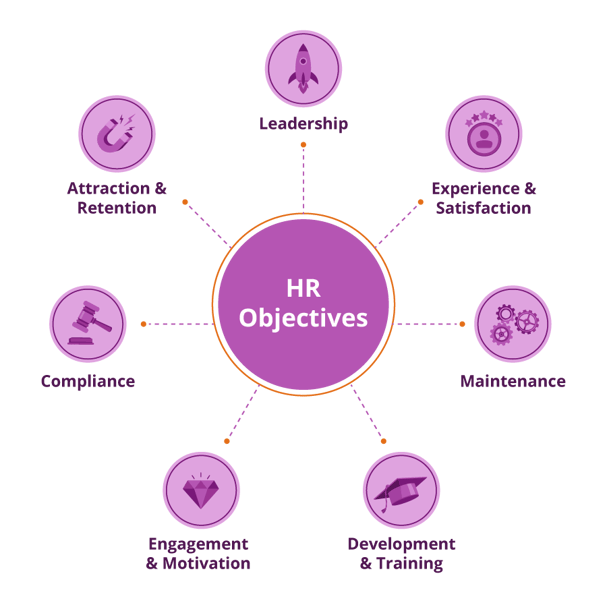
What’s your focus for Human Resources next year? Employee engagement, workplace morale, recruitment, and retention? Whatever it is, setting clear HR objectives will be essential for success.
HR Managers have a lot on their plates managing staff resourcing, culture, and development. Keeping all those plates spinning requires careful planning.
Human resource management (HRM) is the strategic management of people in an organization to improve employee performance and advance the organization’s objectives. It encompasses providing resources and guidance to help employees effectively perform their duties, as well as administrative processes to track and record employee data.
To achieve these goals, everyone in the organization needs to know what the goals are and how they contribute to them. Studies show that companies that focus on their people’s performance are 4.2x more likely to outperform their peers and realize an average 30% higher revenue growth.
Setting effective HR objectives will be the foundation of successful HR plans for 2025. So let's find out how.
What are HR Objectives?
Goals, objectives, and strategies all mean slightly different things, though each feeds into and supports your company's core values. Aligning your strategies and objectives to business goals is imperative.
- A goal is generally broader and longer-term; however shouldn’t be so broad that objectives are hard to create.
- An objective can be defined as a shorter-term, defined, measurable action to achieve an outcome or goal.
- A strategy defines how you will accomplish your objectives.

There are seven core HR objectives your team is likely to focus on.
- Development & training – developing talent and upskilling employee capabilities
- Attraction & retention – recruiting and retaining good talent (including onboarding new hires)
- Engagement & motivation – lifting productivity and recognizing achievement
- Experience & satisfaction – improving company culture and employee experience
- Leadership – strengthening employee links to leaders and organizational goals
- Compliance – ensuring laws and regulations are followed
- Maintenance – maintaining up-to-date processes, policies, and organizational alignment
How to Write HR Goals and Objectives
Writing effective HR goals is a skill not everyone has, but anyone can learn! The most important thing to consider is keeping your goals SMART. That is, ensuring each of your goals is Specific, Measurable, Achievable, Relevant, and Timely. See the next section for some good examples.
In fact, many businesses have expanded this framework to now set SMARTER goals, which add Evaluate and Readjust at the end to reflect the importance of continual improvement.

Using the SMART criteria, you can define and measure specific objectives. SMART goals provide a strong sense of direction, a clear framework to assess progress, and a sense of accountability.
Here are some best practices to help you write HR goals that work.
- Be realistic – shoot for the moon and settle among the stars. Your objectives should be a series of steps to achieve the overall goal, but make sure these are a steady staircase to success, not huge leaps up a mountain!
- Don’t start from scratch – you’ve likely already set numerous goals that can be modified into SMART goals, so rather than creating entirely new goals, turn your existing goals into SMART goals.
- Be resourceful – consider the resources you have available, and whether you’re able to acquire any resources you need, or you may be setting goals that aren’t achievable.
- Data is your friend – utilize data as much as possible to gain insights and create benchmarks for your goals. Don’t have any data? Find the most appropriate way to collect data and get started, use your first data set as a benchmark to gauge progress.
Examples of Smart HR Goals and Objectives
Any HR objective you may have set for the year can be adapted into a SMART goal. By following this approach, you’ll ensure your objectives are designed to contribute to overall organizational goals.
These two HR strategy examples illustrate how to turn your important HR strategic objectives into effective SMART goals.
1. Improve internal communications engagement
Specific: Launch three key communication campaigns (Inform: internal news and updates. Engage: training, development, learning and project opportunities. Excite: team building events, recognition and celebrations, charity work).
Measurable: Increase readership, message engagement and survey responses by 10%.
Achievable: Communication software is in place and the HR and Comms teams have built newsletter and survey templates. An internal communications strategy is in place to craft content and survey content ahead of launches.
Relevant: Increase outgoing internal communications and boost employee engagement.
Timely: Monthly newsletters and quarterly surveys.
Goal: Improve internal communications performance and engagement.
Objectives: Send monthly internal newsletters and quarterly surveys to keep staff informed and measure workplace sentiment. Track the readership and engagement rates with this content. If possible, use previous data to benchmark performance as you go forward to see progress.

2. Increase employee retention
Specific: Introduce new onboarding software and process.
Measurable: Reduce employee churn by 20% by the end of the year.
Achievable: Employee churn rate last year was 72%. HRM software is in place to report on employee numbers.
Relevant: Save time and money on hiring replacements by onboarding employees effectively.
Timely: Year-over-year results.
Goal: Decrease employee churn rates and improve retention strategies
Objectives: Implement new onboarding software and roll out employee training program on new system and related processes. Manage scheduling and participation of training through RSVP alerts to all relevant staff. Use online surveys to capture post-training feedback.
Smart Goals and HR Plans: Bringing it all Together
Congratulations! Now that you have some clear HR objectives set for the year, you’re ready to bring them to life in your annual Human Resources Plan. Download a full HR planning toolkit here.
This is your action plan for delivering effective messaging and amazing campaigns to engage employees, supporting a high-performing workplace and a successful business.
With objectives set, you can plan which employee groups to engage with, what types of messages to deliver, and which communication channels to best reach them with. Equally as importantly, because you’ve set SMART goals, you’ll know exactly how well your activities have performed – and which ones may need some tweaking.
That’s the SMART way of achieving HR management.
Employees are the heart of every business, and HR teams are instrumental in empowering them to achieve great heights. But without clear HR objectives, the heart of the business can become clouded and jaded.



